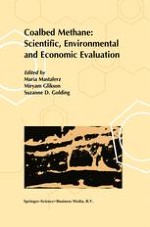1999 | OriginalPaper | Buchkapitel
Coal Composition and Mode of Maturation, a Determining Factor in Quantifying Hydrocarbon Species Generated
verfasst von : M. Glikson, C. J. Boreham, D. S. Thiede
Erschienen in: Coalbed Methane: Scientific, Environmental and Economic Evaluation
Verlag: Springer Netherlands
Enthalten in: Professional Book Archive
Aktivieren Sie unsere intelligente Suche, um passende Fachinhalte oder Patente zu finden.
Wählen Sie Textabschnitte aus um mit Künstlicher Intelligenz passenden Patente zu finden. powered by
Markieren Sie Textabschnitte, um KI-gestützt weitere passende Inhalte zu finden. powered by
Products from various temperatures and heating rates of vitrinite and extractable bitumen from coals of different rank were studied by pyrolysis gas chromatography — mass spectrometry (py-gc-ms) and flash pyrolysis, and compared to ‘naturally’ matured Bowen basin coals. Generation temperatures and quantities of hydrocarbon species from vitrinite and bitumen were shown to be dependant on initial rank of the coal as well, as H/C of vitrinite. A significant amount of bitumen formation characterises rapid heating of vitrinite as established by py-gc-ms, as well as microscopy of residues. Similarly significant bitumen input is noted for Bowen Basin coals, supporting maturation by rapid heating. Using flash pyrolysis, bitumen has been confirmed to be a major source of methane. The light oil during pyrolysis is readily expelled from the coal leaving behind bitumen in vitrinite micro-cleats and char (inertinite) cavities. The ratio of solvent extractable to non-extractable bitumen may be used as indicator of methane generation in these coals.Comparison of open system pyrolysis with confined pyrolysis under varied pressure showed accelaration of organic maturation at presures up to 250 bar, and retardation at higher pressure. Very low pressure of 2–3 bar showed peak bitumen generation at the same tempertaure as in open system. On the other hand, light oil and methane peaked at higher temperature with significantly higher yields that in open system due to bitumen cracking.TEM observations of vitrinite and inertinite (chars) in the coals studied, as well as their residues from pyrolysis experiments highlight differences in microporosity between the two macerals. Microporosity in chars explains diffusion of hydrocarbons through char walls as well as storage of bitumen and gases within the large internal volume of closely spaced micro and nano-pores.The conversion of vitrinite to char has been followed experimentally by heating vitrinite from 300 to 800 degrees C.The gradual development of mosaic texture was recorded by TEM in residues from a range of temperatures. A 3- dimensional reconstruction of mosaic textures facilitates understanding of processes associated with hydrocarbon adsorption and diffusion.
